Odyssey Literary Terms
9 likes6,933 views
A few of the literary devices Mr. Sheehy's class studies while reading The Odyssey.
1 of 11
Downloaded 673 times

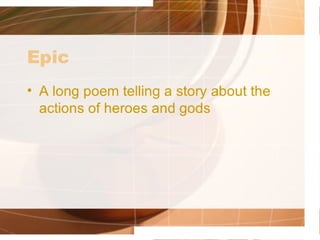
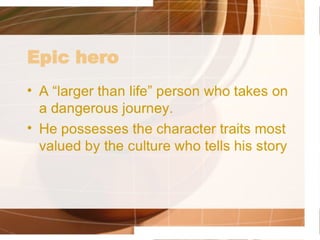

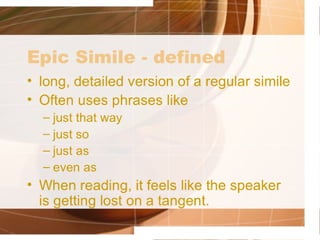
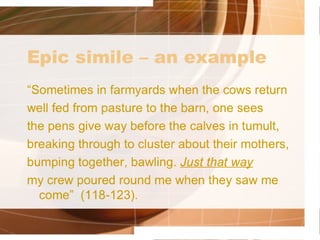

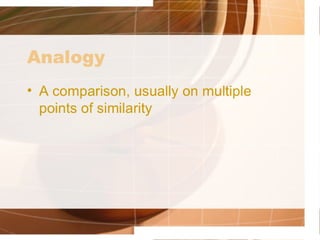
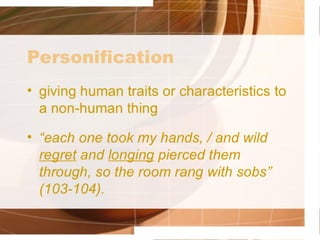
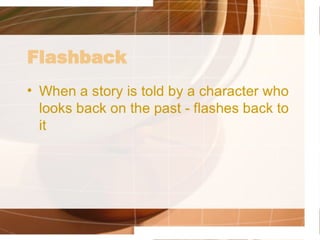
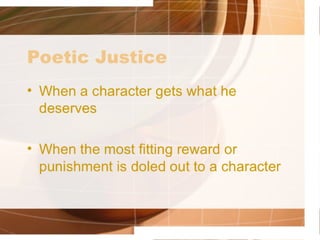
Ad
Recommended
Personfication odyssey
Personfication odysseyHCPSS Ms. Marshall
╠²
The document provides instructions for analyzing examples of personification found in books 1-4 of The Odyssey. Students are asked to identify an example of personification from the text, break it down into its components, and explain what human quality is being given to an object as well as what the underlying meaning is. Analyzing figurative language helps students better understand the text and gain insights into how such techniques are used to convey meaning.Introduction to poetry and the literally devices
Introduction to poetry and the literally devicesTebogo Mothibeli
╠²
The document discusses various elements and concepts related to poetry. It defines poetry and notes that it combines precise word meanings with emotional associations, sounds, and rhythms. It then examines different poetic forms such as sonnets and free verse. Various literary devices used in poetry are also outlined, including metaphor, simile, personification, and onomatopoeia. The document provides examples to illustrate different poetic elements, forms, and literary techniques.Odyssey Jeopardy 2011
Odyssey Jeopardy 2011sfrancetich
╠²
The document contains questions from the game show Jeopardy about the characters, terms, figurative language, vocabulary, and events from Homer's epic poem The Odyssey. There are questions testing knowledge about Odysseus and other characters, literary devices like symbolism and themes, vocabulary words used in the text, and the order of key events in Odysseus' journey home from the Trojan War.Literary terms one ppt
Literary terms one pptmaxwellscorp
╠²
This document defines and provides examples of various literary terms including allegory, archetype, epic, hubris, metonymy, diction, hyperbole, and foil. It instructs students to discuss and analyze examples in short partner and individual activities to demonstrate understanding of each term. Key terms are defined as a story with symbolic meaning (allegory), universally recognizable characters (archetype), heroic poems/stories (epic), excessive pride leading to downfall (hubris), substituting closely related words (metonymy), word choice (diction), exaggeration (hyperbole), and contrasting characters (foil).Heros Journey1
Heros Journey1Andrew Challies
╠²
The document outlines the stages and archetypes of the hero's journey. It describes 12 archetypes grouped into 3 stages: the initiation (innocent, orphan, warrior, caregiver), the journey (seeker, lover, destroyer, creator), and the return (ruler, magician, sage, fool). Each archetype is defined by its goal, fear, problem, task, and virtue. The document provides this information to help people understand and apply the archetypes to their own personal growth and transformation.Odyessey Jeopardy Game
Odyessey Jeopardy Gameshannond304
╠²
The document contains a Jeopardy-style game about Homer's epic poem The Odyssey. It includes categories such as "Gods and Goddess", "Travel", "More Gods", "Home?", and "Fun Facts". Each category contains clues and questions about characters, places, and events from the story. There is also a points value listed for each clue ranging from 100 to 500 points.A-Lose-ion Yourself: A Introduction to the LIterary Device of Allusion
A-Lose-ion Yourself: A Introduction to the LIterary Device of AllusionPaul Wozney
╠²
An introduction to the literary device of allusion through Eminem's anthem Lose Yourself from the OST from the film 8 Mile AND, using this knowledge to respond to text for the English 10 Independent Reading Portfolio project at Charles P. Allen High School.Summary of the Hero's Journey
Summary of the Hero's JourneyDavid Wood
╠²
The document discusses Joseph Campbell's theory of the monomyth or the hero's journey, which is a pattern of narrative archetypes that appears in stories across cultures. It describes the typical stages of the hero's journey as defined by Campbell, including the ordinary world, the call to adventure, crossing a threshold, trials and ordeals, and return with experience. The document also discusses related concepts from Carl Jung and James Joyce and examples of the hero's journey pattern in stories like Star Wars, The Wizard of Oz, and The Hunger Games.Cracr Intro
Cracr Introsheehy
╠²
The notes from a quick lecture about how to detect whether a source is trustworthy.Naturalism and Jack London
Naturalism and Jack Londonsheehy
╠²
The document provides an overview of naturalism as a literary movement and discusses Jack London's writing style. It explains that naturalism depicts humans as subject to hereditary and environmental influences beyond their control. London's stories typically feature lower class characters struggling against hostile natural forces. The document analyzes London's style of interweaving descriptions with observations to convey naturalism's philosophy that nature is indifferent to humanity. It encourages emulating London's style to write a short naturalist story.Separate Peace Characters
Separate Peace Characterssheehy
╠²
Character wheels assembled by Mr. Sheehy's English 10 students as the read the first half of Knowles's A Separate Peace.Research and a Road Trip
Research and a Road Tripsheehy
╠²
The document compares a road trip to writing a research paper, highlighting similarities in planning, organization, and sharing discoveries. It emphasizes the process of choosing a topic, preparing, and documenting experiences, which mirrors the academic research process. Ultimately, it conveys the importance of personal insights in both journeys for engaging the audience.Another Batch of Lit Terms
Another Batch of Lit Termssheehy
╠²
The document outlines key literary terms including character, symbol, setting, and theme. It describes characters as either static or dynamic, and round or flat, along with the concept of character foils. Additionally, it explains that symbols represent greater meanings, settings establish the time and place of a narrative, and themes are essential insights explored in literature.Citations in a Research Paper
Citations in a Research Papersheehy
╠²
The document provides guidelines for properly citing sources in research papers, including:
- Placing citations in parentheses with the author's last name and page number
- Putting the period after the parenthetical citation
- Citing a source once for multiple consecutive sentences using the same source
- Citing wherever information is borrowed, not just direct quotes
- Including a citation after each quote
- Changing the citation if the page number changes for the same source
- Omitting the page number if the source doesn't include one
- Substituting the title for the author if the source doesn't include an authorHemingway's "In Another Country"
Hemingway's "In Another Country"sheehy
╠²
The document provides background information on Hemingway's short story "In Another Country". It discusses how World War I resulted in unprecedented casualties and injuries due to advancements in weaponry outpacing military tactics. Many soldiers returned home disfigured or with psychological wounds. Hemingway himself served as a Red Cross ambulance driver during World War I and was injured by shell fragments. The story describes the experiences of an American soldier recuperating in a military hospital in Italy after a leg injury, who feels isolated from other wounded soldiers once they believe his medals were merely for being American rather than acts of valor.Putting Quotes in a Paper
Putting Quotes in a Papersheehy
╠²
The document provides guidance on incorporating quotes into academic papers in 3 main ways:
1. Using a colon to introduce a quote that supports the preceding statement.
2. Using no punctuation by blending the quote into your own writing.
3. Using commas to introduce a quote with an introductory phrase that cannot stand alone as a sentence.
It also discusses proper punctuation placement for quotes and line references in parentheses. Examples are provided for each quoting method.5 Paragraph Essay Construction
5 Paragraph Essay Constructionsheehy
╠²
The document outlines the structure and components of a 5-paragraph essay, emphasizing the importance of a strong introduction with an attention-grabber and a clear thesis statement. It instructs on developing supporting paragraphs with topic sentences and concluding with a reinforced thesis. Each section should maintain coherence and flow to effectively communicate the main ideas.Essay Plan of Attack
Essay Plan of Attacksheehy
╠²
The essay suggests starting in the middle of writing rather than at the beginning to alleviate stress, as beginning can be frustrating and time-consuming. It emphasizes the importance of revisiting the beginning after establishing the main content and saving the ending for last. This approach can lead to greater happiness in the writing process.Revising Descriptive Writing
Revising Descriptive Writingsheehy
╠²
The document provides tips for revising descriptive writing in English, emphasizing the elimination of weak phrases like 'I feel' to enhance vivid imagery. It advises maintaining consistent verb tenses and ensuring that gerunds or participles have a main verb. Overall, the guidelines focus on strengthening sentence structure and clarity.R J Powerpoint
R J Powerpointsheehy
╠²
The document is a compilation of notable quotes from Shakespeare's 'Romeo and Juliet,' highlighting key moments and emotions expressed by the characters. Quotes include Romeo's admiration for Juliet, Tybalt's animosity towards Romeo, and the themes of love and tragedy that permeate the play. Additionally, the document features original images related to the themes and characters of the story.Web Tools for Teaching
Web Tools for Teachingsheehy
╠²
This document discusses using web tools to aid teaching. The author's goal is to expose teachers to relevant communication and collaboration tools over five days that can help teachers interact with students and families, and engage students through interactive learning materials, teachers, and peers. The author maintains that technology helps with communication and interaction, connecting to students' interests while teaching crucial modern skills, and that practice and time are needed for learning.Romeo and Juliet: A closer look
Romeo and Juliet: A closer looksheehy
╠²
The document explores the prologue and key themes of Shakespeare's play, focusing on the tragic story of two rival families in Verona and their star-crossed lovers. It discusses literary devices such as puns, oxymorons, and soliloquies, illustrating how these enhance the play's exploration of fate and love. Additionally, it highlights character motivations, emotional complexities, and the societal context that shapes their actions.Irony
Ironysheehy
╠²
Irony can be understood in three forms: dramatic irony occurs when the audience knows something a character does not; situational irony is when something happens opposite of expectations; and verbal irony is when a person says one thing but means something else, such as with sarcasm.Poetry 9 Terms Review
Poetry 9 Terms Review sheehy
╠²
The document discusses different elements of poetry including structure, sounds, pictures, and stories. It defines poetic structures like stanzas, repetition, and rhyme. It also defines poetic devices that create sound, imagery, and meaning including alliteration, assonance, onomatopoeia, metaphor, simile, and personification. Finally, it discusses ballads as a type of poetic storytelling structure.Elements of a Story
Elements of a Storysheehy
╠²
The document outlines the four main elements of a story: point of view, characters, plot, and setting. It then provides more details on each element, such as the different points of view and types of characters. The document also describes the typical six points on a plot curve: exposition, inciting moment, rising action, climax, falling action, and resolution. Finally, it discusses how characters can be static or dynamic and the different ways of characterizing them through direct or indirect means.More Related Content
More from sheehy (20)
Cracr Intro
Cracr Introsheehy
╠²
The notes from a quick lecture about how to detect whether a source is trustworthy.Naturalism and Jack London
Naturalism and Jack Londonsheehy
╠²
The document provides an overview of naturalism as a literary movement and discusses Jack London's writing style. It explains that naturalism depicts humans as subject to hereditary and environmental influences beyond their control. London's stories typically feature lower class characters struggling against hostile natural forces. The document analyzes London's style of interweaving descriptions with observations to convey naturalism's philosophy that nature is indifferent to humanity. It encourages emulating London's style to write a short naturalist story.Separate Peace Characters
Separate Peace Characterssheehy
╠²
Character wheels assembled by Mr. Sheehy's English 10 students as the read the first half of Knowles's A Separate Peace.Research and a Road Trip
Research and a Road Tripsheehy
╠²
The document compares a road trip to writing a research paper, highlighting similarities in planning, organization, and sharing discoveries. It emphasizes the process of choosing a topic, preparing, and documenting experiences, which mirrors the academic research process. Ultimately, it conveys the importance of personal insights in both journeys for engaging the audience.Another Batch of Lit Terms
Another Batch of Lit Termssheehy
╠²
The document outlines key literary terms including character, symbol, setting, and theme. It describes characters as either static or dynamic, and round or flat, along with the concept of character foils. Additionally, it explains that symbols represent greater meanings, settings establish the time and place of a narrative, and themes are essential insights explored in literature.Citations in a Research Paper
Citations in a Research Papersheehy
╠²
The document provides guidelines for properly citing sources in research papers, including:
- Placing citations in parentheses with the author's last name and page number
- Putting the period after the parenthetical citation
- Citing a source once for multiple consecutive sentences using the same source
- Citing wherever information is borrowed, not just direct quotes
- Including a citation after each quote
- Changing the citation if the page number changes for the same source
- Omitting the page number if the source doesn't include one
- Substituting the title for the author if the source doesn't include an authorHemingway's "In Another Country"
Hemingway's "In Another Country"sheehy
╠²
The document provides background information on Hemingway's short story "In Another Country". It discusses how World War I resulted in unprecedented casualties and injuries due to advancements in weaponry outpacing military tactics. Many soldiers returned home disfigured or with psychological wounds. Hemingway himself served as a Red Cross ambulance driver during World War I and was injured by shell fragments. The story describes the experiences of an American soldier recuperating in a military hospital in Italy after a leg injury, who feels isolated from other wounded soldiers once they believe his medals were merely for being American rather than acts of valor.Putting Quotes in a Paper
Putting Quotes in a Papersheehy
╠²
The document provides guidance on incorporating quotes into academic papers in 3 main ways:
1. Using a colon to introduce a quote that supports the preceding statement.
2. Using no punctuation by blending the quote into your own writing.
3. Using commas to introduce a quote with an introductory phrase that cannot stand alone as a sentence.
It also discusses proper punctuation placement for quotes and line references in parentheses. Examples are provided for each quoting method.5 Paragraph Essay Construction
5 Paragraph Essay Constructionsheehy
╠²
The document outlines the structure and components of a 5-paragraph essay, emphasizing the importance of a strong introduction with an attention-grabber and a clear thesis statement. It instructs on developing supporting paragraphs with topic sentences and concluding with a reinforced thesis. Each section should maintain coherence and flow to effectively communicate the main ideas.Essay Plan of Attack
Essay Plan of Attacksheehy
╠²
The essay suggests starting in the middle of writing rather than at the beginning to alleviate stress, as beginning can be frustrating and time-consuming. It emphasizes the importance of revisiting the beginning after establishing the main content and saving the ending for last. This approach can lead to greater happiness in the writing process.Revising Descriptive Writing
Revising Descriptive Writingsheehy
╠²
The document provides tips for revising descriptive writing in English, emphasizing the elimination of weak phrases like 'I feel' to enhance vivid imagery. It advises maintaining consistent verb tenses and ensuring that gerunds or participles have a main verb. Overall, the guidelines focus on strengthening sentence structure and clarity.R J Powerpoint
R J Powerpointsheehy
╠²
The document is a compilation of notable quotes from Shakespeare's 'Romeo and Juliet,' highlighting key moments and emotions expressed by the characters. Quotes include Romeo's admiration for Juliet, Tybalt's animosity towards Romeo, and the themes of love and tragedy that permeate the play. Additionally, the document features original images related to the themes and characters of the story.Web Tools for Teaching
Web Tools for Teachingsheehy
╠²
This document discusses using web tools to aid teaching. The author's goal is to expose teachers to relevant communication and collaboration tools over five days that can help teachers interact with students and families, and engage students through interactive learning materials, teachers, and peers. The author maintains that technology helps with communication and interaction, connecting to students' interests while teaching crucial modern skills, and that practice and time are needed for learning.Romeo and Juliet: A closer look
Romeo and Juliet: A closer looksheehy
╠²
The document explores the prologue and key themes of Shakespeare's play, focusing on the tragic story of two rival families in Verona and their star-crossed lovers. It discusses literary devices such as puns, oxymorons, and soliloquies, illustrating how these enhance the play's exploration of fate and love. Additionally, it highlights character motivations, emotional complexities, and the societal context that shapes their actions.Irony
Ironysheehy
╠²
Irony can be understood in three forms: dramatic irony occurs when the audience knows something a character does not; situational irony is when something happens opposite of expectations; and verbal irony is when a person says one thing but means something else, such as with sarcasm.Poetry 9 Terms Review
Poetry 9 Terms Review sheehy
╠²
The document discusses different elements of poetry including structure, sounds, pictures, and stories. It defines poetic structures like stanzas, repetition, and rhyme. It also defines poetic devices that create sound, imagery, and meaning including alliteration, assonance, onomatopoeia, metaphor, simile, and personification. Finally, it discusses ballads as a type of poetic storytelling structure.Elements of a Story
Elements of a Storysheehy
╠²
The document outlines the four main elements of a story: point of view, characters, plot, and setting. It then provides more details on each element, such as the different points of view and types of characters. The document also describes the typical six points on a plot curve: exposition, inciting moment, rising action, climax, falling action, and resolution. Finally, it discusses how characters can be static or dynamic and the different ways of characterizing them through direct or indirect means.Recently uploaded (20)
How to Manage Upselling of Subscriptions in Odoo 18
How to Manage Upselling of Subscriptions in Odoo 18Celine George
╠²
Subscriptions in Odoo 18 are designed to auto-renew indefinitely, ensuring continuous service for customers. However, businesses often need flexibility to adjust pricing or quantities based on evolving customer needs.2025 June Year 9 Presentation: Subject selection.pptx
2025 June Year 9 Presentation: Subject selection.pptxmansk2
╠²
2025 June Year 9 Presentation: Subject selectionNon-Communicable Diseases and National Health Programs ŌĆō Unit 10 | B.Sc Nursi...
Non-Communicable Diseases and National Health Programs ŌĆō Unit 10 | B.Sc Nursi...RAKESH SAJJAN
╠²
This PowerPoint presentation is prepared for Unit 10 ŌĆō Non-Communicable Diseases and National Health Programs, as per the 5th Semester B.Sc Nursing syllabus outlined by the Indian Nursing Council (INC) under the subject Community Health Nursing ŌĆō I.
This unit focuses on equipping students with knowledge of the causes, prevention, and control of non-communicable diseases (NCDs), which are a major public health challenge in India. The presentation emphasizes the nurseŌĆÖs role in early detection, screening, management, and referral services under national-level programs.
¤ö╣ Key Topics Included:
Definition, burden, and impact of NCDs in India
Epidemiology, risk factors, signs/symptoms, prevention, and management of:
Diabetes Mellitus
Hypertension
Cardiovascular Diseases
Stroke & Obesity
Thyroid Disorders
Blindness
Deafness
Injuries and Accidents (incl. road traffic injuries and trauma guidelines)
NCD-2 Cancers:
Breast Cancer
Cervical Cancer
Oral Cancer
Risk factors, screening, diagnosis, early signs, referral & palliative care
Role of nurse in screening, referral, counseling, and continuum of care
National Programs:
National Program for Prevention and Control of Cancer, Diabetes, Cardiovascular Diseases and Stroke (NPCDCS)
National Program for Control of Blindness
National Program for Prevention and Control of Deafness
National Tobacco Control Program (NTCP)
Introduction to Universal Health Coverage and Ayushman Bharat
Use of standard treatment protocols and referral flowcharts
This presentation is ideal for:
Classroom lectures, field assignments, health education planning, and student projects
Preparing for university exams, class tests, and community field postingsTHERAPEUTIC COMMUNICATION included definition, characteristics, nurse patient...
THERAPEUTIC COMMUNICATION included definition, characteristics, nurse patient...parmarjuli1412
╠²
The document provides an overview of therapeutic communication, emphasizing its importance in nursing to address patient needs and establish effective relationships. THERAPEUTIC COMMUNICATION included some topics like introduction of COMMUNICATION, definition, types, process of communication, definition therapeutic communication, goal, techniques of therapeutic communication, non-therapeutic communication, few ways to improved therapeutic communication, characteristics of therapeutic communication, barrier of THERAPEUTIC RELATIONSHIP, introduction of interpersonal relationship, types of IPR, elements/ dynamics of IPR, introduction of therapeutic nurse patient relationship, definition, purpose, elements/characteristics , and phases of therapeutic communication, definition of Johari window, uses, what actually model represent and its areas, THERAPEUTIC IMPASSES and its management in 5th semester Bsc. nursing and 2nd GNM studentsBattle of Bookworms 2025 - U25 Literature Quiz by Pragya
Battle of Bookworms 2025 - U25 Literature Quiz by Pragya Pragya - UEM Kolkata Quiz Club
╠²
Battle of Bookworms is a literature quiz organized by Pragya, UEM Kolkata, as part of their cultural fest Ecstasia. Curated by quizmasters Drisana Bhattacharyya, Argha Saha, and Aniket Adhikari, the quiz was a dynamic mix of classical literature, modern writing, mythology, regional texts, and experimental literary forms. It began with a 20-question prelim round where ŌĆśstar questionsŌĆÖ played a key tie-breaking role. The top 8 teams moved into advanced rounds, where they faced audio-visual challenges, pounce/bounce formats, immunity tokens, and theme-based risk-reward questions. From Orwell and Hemingway to Tagore and Sarala Das, the quiz traversed a global and Indian literary landscape. Unique rounds explored slipstream fiction, constrained writing, adaptations, and true crime literature. It included signature IDs, character identifications, and open-pounce selections. Questions were crafted to test contextual understanding, narrative knowledge, and authorial intent, making the quiz both intellectually rewarding and culturally rich. Battle of Bookworms proved literature quizzes can be insightful, creative, and deeply enjoyable for all.How to Create an Event in Odoo 18 - Odoo 18 ║▌║▌▀Żs
How to Create an Event in Odoo 18 - Odoo 18 ║▌║▌▀ŻsCeline George
╠²
Creating an event in Odoo 18 is a straightforward process that allows you to manage various aspects of your event efficiently.
Odoo 18 Events Module is a powerful tool for organizing and managing events of all sizes, from conferences and workshops to webinars and meetups. Overview of Employee in Odoo 18 - Odoo ║▌║▌▀Żs
Overview of Employee in Odoo 18 - Odoo ║▌║▌▀ŻsCeline George
╠²
The employee module is a core component of the HR workspace that helps the business to get the employee activities and details. This would also allow you to get the employee details by acting as a centralized system and accessing, updating, and managing all the other employee data. How to Configure Vendor Management in Lunch App of Odoo 18
How to Configure Vendor Management in Lunch App of Odoo 18Celine George
╠²
The Vendor management in the Lunch app of Odoo 18 is the central hub for managing all aspects of the restaurants or caterers that provide food for your employees. GEOGRAPHY-Study Material [ Class 10th] .pdf
GEOGRAPHY-Study Material [ Class 10th] .pdfSHERAZ AHMAD LONE
╠²
"Geography Study Material for Class 10th" provides a comprehensive and easy-to-understand resource for key topics like Resources & Development, Water Resources, Agriculture, Minerals & Energy, Manufacturing Industries, and Lifelines of the National Economy. Designed as per the latest NCERT/JKBOSE syllabus, it includes notes, maps, diagrams, and MODEL question Paper to help students excel in exams. Whether revising for exams or strengthening conceptual clarity, this material ensures effective learning and high scores. Perfect for last-minute revisions and structured study sessions.Chalukyas of Gujrat, Solanki Dynasty NEP.pptx
Chalukyas of Gujrat, Solanki Dynasty NEP.pptxDr. Ravi Shankar Arya Mahila P. G. College, Banaras Hindu University, Varanasi, India.
╠²
This presentation has been made keeping in mind the students of undergraduate and postgraduate level. In this slide try to present the brief history of Chaulukyas of Gujrat up to Kumarpala To keep the facts in a natural form and to display the material in more detail, the help of various books, websites and online medium has been taken. Whatever medium the material or facts have been taken from, an attempt has been made by the presenter to give their reference at the end.
Chaulukya or Solanki was one of the Rajputs born from Agnikul. In the Vadnagar inscription, the origin of this dynasty is told from Brahma's Chauluk or Kamandalu. They ruled in Gujarat from the latter half of the tenth century to the beginning of the thirteenth century. Their capital was in Anahilwad. It is not certain whether it had any relation with the Chalukya dynasty of the south or not. It is worth mentioning that the name of the dynasty of the south was 'Chaluky' while the dynasty of Gujarat has been called 'Chaulukya'. The rulers of this dynasty were the supporters and patrons of Jainism.Sustainable Innovation with Immersive Learning
Sustainable Innovation with Immersive LearningLeonel Morgado
╠²
Prof. Leonel and Prof. Dennis approached educational uses, practices, and strategies of using immersion as a lens to interpret, design, and planning educational activities in a sustainable way. Rather than one-off gimmicks, the intent is to enable instructors (and institutions) to be able to include them in their regular activities, including the ability to evaluate and redesign them.
Immersion as a phenomenon enables interpreting pedagogical activities in a learning-agnostic way: you take a stance on the learning theory to follow, and leverage immersion to envision and guide your practice.Overview of Off Boarding in Odoo 18 Employees
Overview of Off Boarding in Odoo 18 EmployeesCeline George
╠²
When an employee leaves the company, Odoo provides a streamlined offboarding process to ensure all necessary steps are taken. LDMMIA GRAD Student Check-in Orientation Sampler
LDMMIA GRAD Student Check-in Orientation SamplerLDM & Mia eStudios
╠²
Completed Tuesday June 10th.
An Orientation Sampler of 8 pages.
It helps to understand the text behind anything. This improves our performance and confidence.
Your training will be mixed media. Includes Rehab Intro and Meditation vods, all sold separately.
Editing our Vods & New Shop.
Retail under $30 per item. Store Fees will apply. Digital Should be low cost.
I am still editing the package. I wont be done until probably July? However; Orientation and Lecture 1 (Videos) will be available soon. Media will vary between PDF and Instruction Videos.
Thank you for attending our free workshops. Those can be used with any Reiki Yoga training package. Traditional Reiki does host rules and ethics. Its silent and within the JP Culture/Area/Training/Word of Mouth. It allows remote healing but thereŌĆÖs limits for practitioners and masters. We are not allowed to share certain secrets/tools. Some content is designed only for ŌĆ£MastersŌĆØ. Some yoga are similar like the Kriya Yoga-Church (Vowed Lessons). We will review both Reiki and Yoga (Master symbols) later on. Sounds Simple but these things host Energy Power/Protection.
Imagine This package will be a supplement or upgrade for professional Reiki. You can create any style you need.
ŌÖźŌÖźŌÖź
ŌĆó* ╠ü ╠ł ╠¦.ŌĆó
(Job) Tech for students: In short, high speed is essential. (Space, External Drives, virtual clouds)
Fast devices and desktops are important. Please upgrade your technology and office as needed and timely. - MIA J. Tech Dept (Timeless)
ŌÖźŌÖźŌÖź
ŌĆó* ╠ü ╠ł ╠¦.ŌĆó
Copyright Disclaimer 2007-2025+: These lessons are not to be copied or revised without the
AuthorŌĆÖs permission. These Lessons are designed Rev. Moore to instruct and guide students on the path to holistic health and wellness.
ItŌĆÖs about expanding your Nature Talents, gifts, even Favorite Hobbies.
ŌÖźŌÖźŌÖź
ŌĆó* ╠ü ╠ł ╠¦.ŌĆó
First, Society is still stuck in the matrix. Many of the spiritual collective, say the matrix crashed. Its now collapsing. This means anything lower, darker realms, astral, and matrix are below 5D. 5D is thee trend. ItŌĆÖs our New Dimensional plane. However; this plane takes work ethic,
integration, and self discovery. ŌÖźŌÖźŌÖź
ŌĆó* ╠ü ╠ł ╠¦.ŌĆó
We donŌĆÖt need to slave, mule, or work double shifts to fuse Reiki lol. It should blend naturally within our lifestyles. Same with Yoga. ThereŌĆÖs no
need to use all the poses/asanas. For under a decade, my fav exercises are not asanas but Pilates. ItŌĆÖs all about Yoga-meditation when using Reiki. (Breaking old myths.)
Thank You for reading our Orientation Sampler. The Workshop is 14 pages on introduction. These are a joy and effortless to produce/make.Revista digital preescolar en transformaci├│n
Revista digital preescolar en transformaci├│nguerragallardo26
╠²
EVOLUCI├ōN DEL CONTENIDO DE LA EVALUACI├ōN DE LOS RECURSOS Y DE LA FORMACI├ōN DE LOS DOCENTESABCs of Bookkeeping for Nonprofits TechSoup.pdf
ABCs of Bookkeeping for Nonprofits TechSoup.pdfTechSoup
╠²
Accounting can be hard enough if you havenŌĆÖt studied it in school. Nonprofit accounting is actually very different and more challenging still.
Need help? Join Nonprofit CPA and QuickBooks expert Gregg Bossen in this first-time webinar and learn the ABCs of keeping books for a nonprofit organization.
Key takeaways
* What accounting is and how it works
* How to read a financial statement
* What financial statements should be given to the board each month
* What three things nonprofits are required to track
What features to use in QuickBooks to track programs and grantsBINARY files CSV files JSON files with example.pptx
BINARY files CSV files JSON files with example.pptxRamakrishna Reddy Bijjam
╠²
BINARY FILES, CSV FILESChalukyas of Gujrat, Solanki Dynasty NEP.pptx
Chalukyas of Gujrat, Solanki Dynasty NEP.pptxDr. Ravi Shankar Arya Mahila P. G. College, Banaras Hindu University, Varanasi, India.
╠²
Ad
